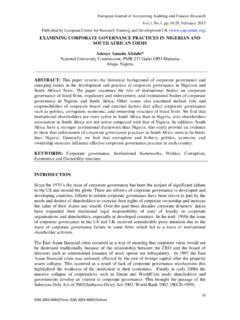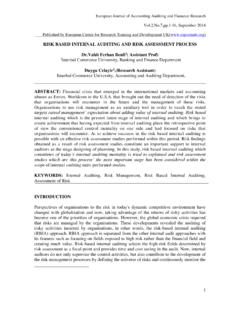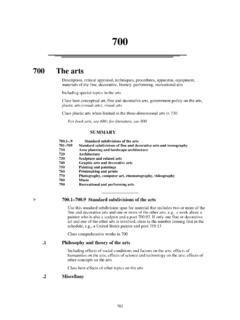Transcription of A REVIEW ANALYSIS OF ANCIENT GREEK ARCHITECTURE …
1 International Journal of Civil Engineering, Construction and Estate Management , , , June 2015 ___Published by European Centre for Research Training and Development UK ( ) 48 A REVIEW ANALYSIS OF ANCIENT GREEK ARCHITECTURE Mir Mohammad Azad1 1 Department of Computer Science and Engineering Abhik Barua2 2 Department of Interior ARCHITECTURE Shrmin Sultana3 3 Department of Interior ARCHITECTURE Shanto-Mariam University of Creative Technology House # 01,Road # 14, Sector # 13, Uttara, Dhaka, Bangladesh ABSTRACT: The ARCHITECTURE of ANCIENT Greece is the ARCHITECTURE produced by the GREEK -speaking people (Hellenic people) whose culture flourished on the GREEK mainland and Peloponnesus, the Aegean Islands, and in colonies in Asia Minor and Italy for a period from about 900 BC until the 1st century AD, with the earliest remaining architectural works dating from around 600 BC.
2 ANCIENT GREEK ARCHITECTURE is best known from its temples, many of which are found throughout the region, mostly as ruins but many substantially intact. The second important type of building that survives all over the Hellenic world is the open-air theatre, with the earliest dating from around 350 BC. Other architectural forms that are still in evidence are the processional gateway (propylon), the public square (agora) surrounded by storied colonnade (stoa), the town council building (bouleuterion), the public monument, the monumental tomb (mausoleum) and the stadium. KEYWORDS: GREEK ARCHITECTURE , ANCIENT Greece. INTRODUCTION ANCIENT GREEK ARCHITECTURE is distinguished by its highly formalised characteristics, both of structure and decoration. This is particularly so in the case of temples where each building appears to have been conceived as a sculptural entity within the landscape, most often raised on high ground so that the elegance of its proportions and the effects of light on its surfaces might be viewed from all angles.
3 Nikolaus Pevsner refers to "the plastic shape of the [ GREEK ] before us with a physical presence more intense, more alive than that of any later building".The formal vocabulary of ANCIENT GREEK ARCHITECTURE , in particular the division of architectural style into three defined orders: the Doric Order, the Ionic Order and the Corinthian Order, was to have profound effect on Western ARCHITECTURE of later periods. The ARCHITECTURE of ANCIENT Rome grew out of that of Greece and maintained its influence in Italy unbroken until the present day. From the Renaissance, revivals of Classicism International Journal of Civil Engineering, Construction and Estate Management , , , June 2015 ___Published by European Centre for Research Training and Development UK ( ) 49 have kept alive not only the precise forms and ordered details of GREEK ARCHITECTURE , but also its concept of architectural beauty based on balance and proportion.
4 The successive styles of Neoclassical ARCHITECTURE and GREEK Revival ARCHITECTURE followed and adapted ANCIENT GREEK styles closely INFLUENCES Geography The mainland and islands of Greece are rocky, with deeply indented coastline, and rugged mountain ranges with few substantial forests. The most freely available building material is stone. Limestone was readily available and easily worked. There is an abundance of high quality white marble both on the mainland and islands, particularly Paros and Naxos. This finely grained material was a major contributing factor to precision of detail, both architectural and sculptural, that adorned ANCIENT GREEK ARCHITECTURE . Deposits of high quality potter's clay were found throughout Greece and the Islands, with major deposits near Athens. It was used not only for pottery vessels, but also roof tiles and architectural decoration.
5 The climate of Greece is maritime, with both the coldness of winter and the heat of summer tempered by sea breezes. This led to a lifestyle where many activities took place outdoors. Hence temples were placed on hilltops, their exteriors designed as a visual focus of gatherings and processions, while theatres were often an enhancement of a naturally occurring sloping site where people could sit, rather than a containing structure. Colonnades encircling buildings, or surrounding courtyards provided shelter from the sun and from sudden winter storms. The rugged indented coastline at Rhamnous, Attica The Theatre and Temple of Apollo in mountainous country at Delphi The Acropolis, Athens, is high above the city on a natural prominence. The Islands of the Aegean from Cape Sounion International Journal of Civil Engineering, Construction and Estate Management , , , June 2015 ___Published by European Centre for Research Training and Development UK ( ) 50 HISTORY The history of the ANCIENT GREEK civilization is divided into two eras, the Hellenic and the Hellenistic.
6 The Hellenic period commenced circa 900 BC (with substantial works of ARCHITECTURE appearing from about 600 BC), and ended with the death of Alexander the Great in 323 BC. During the Hellenistic period, 323 BC - AD 30, Hellenic culture was spread widely, firstly throughout lands conquered by Alexander, and then by the Roman Empire which absorbed much of GREEK culture. Prior to the Hellenic era, two civilizations had existed within the region, the Minoan and the Mycenaean. Minoan is the name given by modern historians to the people of ANCIENT Crete (c. 2800 1100 BC), known for their elaborate and richly decorated palaces, and for their pottery painted with floral and marine motifs. The Mycenaean culture occurred on the Peloponnesus ( 1100 BC) and was quite different in character, building citadels, fortifications and tombs rather than palaces, and decorating their pottery with bands of marching soldiers rather than octopus and seaweed.
7 Both these civilizations came to an end around 1100 BC, that of Crete possibly because of volcanic devastation, and that of Mycenae because of invasion from Dorian people of the GREEK mainland. This led to a period with few remaining signs of culture, and thus often referred to as a Dark Age. The art history of the Hellenic era is generally subdivided into four periods, the Protogeometric (1100-900 BC), the Geometric (900-700 BC), the Archaic (700 - 500 BC) and the Classical (500 - 323 BC) with sculpture being further divided into Severe Classical, High Classical and Late Classical. The first signs of the particular artistic character that defines ANCIENT GREEK ARCHITECTURE are to be seen in the pottery of the Dorian Greeks from the 10th century BC. Already at this period it is created with a sense of proportion, symmetry and balance not apparent in similar pottery from Crete and Mycenae.
8 The decoration is precisely geometric, and ordered neatly into zones on defined areas of each vessel. These qualities were to manifest themselves not only through a millennium of GREEK pottery making, but also in the ARCHITECTURE that was to emerge in the 6th century. RELIGION AND PHILOSOPHY Left : Modern model of ANCIENT Olympia with the Temple of Zeus at the centre Right: Recreation of the colossal statue of Athena, once housed in the Parthenon, with sculptor Alan LeQuire International Journal of Civil Engineering, Construction and Estate Management , , , June 2015 ___Published by European Centre for Research Training and Development UK ( ) 51 The religion of ANCIENT Greece was a form of nature worship that grew out of the beliefs of earlier cultures. However, unlike earlier cultures, man was no longer perceived as being threatened by nature, but as its sublime product.
9 The natural elements were personified as gods of completely human form, and very human behaviour. The home of the gods was thought to be Olympus, the highest mountain in Greece. The most important deities were: Zeus, the supreme god and ruler of the sky; Hera, his wife and goddess of marriage; Athena, goddess of wisdom; Poseidon, god of the sea; Demeter, goddess of the earth; Apollo, god of the sun, law, reason, music and poetry; Artemis, goddess of the moon, the hunt and the wilderness; Aphrodite, goddess of love; Ares, God of war; Hermes, god of commerce and medicine, and Hephaestus, god of fire and metalwork. Worship, like many other activities, was done in community, in the open. However, by 600 BC, the gods were often represented by large statues and it was necessary to provide a building in which each of these could be housed.
10 This led to the development of temples. ARCHITECTURAL CHARACTER Early development There is a clear division between the ARCHITECTURE of the preceding Mycenaean culture and Minoan cultures and that of the ANCIENT Greeks, the techniques and an understanding of their style being lost when these civilizations Minoan ARCHITECTURE of Crete, was of trabeated form like that of ANCIENT Greece. It employed wooden columns with capitals, but the columns were of very different form to Doric columns, being narrow at the base and splaying upward. The earliest forms of columns in Greece seem to have developed independently. As with Minoan ARCHITECTURE , ANCIENT GREEK domestic ARCHITECTURE centred on open spaces or courtyards surrounded by colonnades. This form was adapted to the construction of hypostyle halls within the larger temples.














